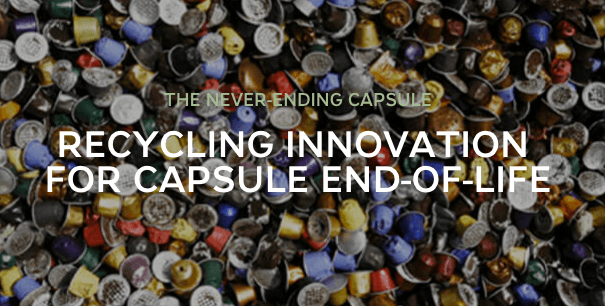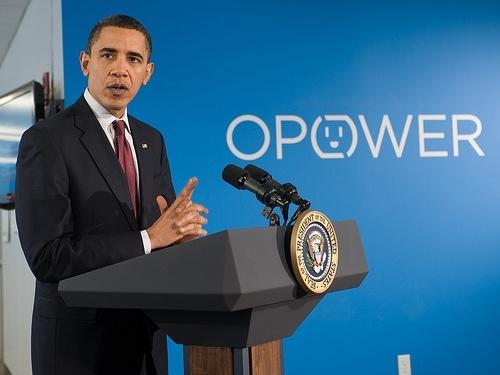Nespresso Expands U.S. Recycling Program, But Is It Enough?


It is hard to think of a product more useless, and with a larger environmental impact, than bottled water — although those single-use coffee pods come pretty close. Largely popularized because of the longstanding partnership between Keurig and Green Mountain Roasters, coffee pods have surged in popularity over the past decade because of their convenience. Just about every coffee brand has a line of machines and pods, including a Starbucks machine that was hilariously parodied by Saturday Night Live.
But coffee pods pose their share of recycling challenges. Sure, you can scoop out those coffee grinds for your garden, wash out the aluminum or resin-based pods, and recycle the components. But most consumers will laugh if you suggest such an idea. In Canada, Office Max and TerraCycle launched an in-store pilot recycling project for coffee pods, and even expanded the program, but that effort is a drop in the bucket as the vast majority of pods go into landfills.
Now Nespresso, a successful coffee pod maker (and coffee disks, just to be clear) due in part to having George Clooney has a spokesman, says it is increasing its waste-diversion and recycling efforts here in the U.S.
In a widely disseminated press release, Nespresso announced it has expanded a pilot coffee-pod recycling program from 20 states to the contiguous 48 states of the U.S. In a partnership with UPS, Nespresso users can plonk their used aluminum pods into a pre-paid UPS bag, drop them off at just about any UPS pick-up location (or a local Office Depot or Staples) or have your local courier pick them up at your doorstep, and UPS will send them to one of Nespresso’s partner recycling facilities.
No word yet on what incentives will be offered to consumers that bother to ship their used coffee pods. Currently, once delivered to a recycling center, the capsules are shredded and the various materials are separated. Any coffee grounds are sifted and shipped to an industrial composting plant.
In theory, Nespresso diverts the new raw materials to companies such as TerraCycle, which either upcycle the material or churn it into new products. Participants in the program can accrue points, which can then be converted into donations for local nonprofits or schools. But the program with TerraCycle has tapped out in Canada — the company is no longer accepting new participants, and it has requested that consumers who want to rid themselves of those pods find other ways in which to recycle them.
In an email to TriplePundit, a Nespresso spokesperson described the expanded recycling effort as “the latest development in Nespresso’s sustainability strategy, in which they have prioritized recycling and creating a sustainable value chain.”
Clearly Nestlé, Nespresso’s parent company, touts such a program as part of the company’s “shared value” mission. But the reality is that if something cannot go into the blue bin, most likely that item is not going to be recycled, even if it can be picked up and shipped for free. In the case of these Nespresso pods, shared value it is Nestlé -- and the consultancies advising the company on such strategies -- the score the financial benefits, while municipalities pick up the tab for hauling and landfilling the waste.
As one TriplePundit commentator recently pointed out, Nestlé is actually in the position to use more responsible and sustainable (as in: recycled) materials. But instead, the company designed these pods and machines for maximum commercial gain — and expects a few textbooks or some donated play equipment to balance out any environmental impact. Meanwhile, Nespresso will point to other projects, such as working with farmers in South Sudan, as showing that its “EcoLaboration” works.
Not everyone is buying into Nespresso’s communications plans. The city of Hamburg, Germany, banned the use of those single-use coffee pods in government buildings earlier this year, the BBC reported. Do not be surprised as more municipalities, in trying to set an example for their citizens with it comes to sustainable behavior, follow the lead of Germany’s second largest city.
Image credit: Nespresso
Trix Cereals Ditch Artificial Colors, But Consumers Don’t Care


Now is not the best time to be in the artificial color industry. Food companies including Mars, Nestlé USA and Kraft have either ditched, or plan to eliminate, artificial food dyes from their products. Some of the reasons include alleged links between artificial colors and health problems like hyperactivity in children.
But at a time when consumers want more transparency about the ingredients in their food, and are willing to pay a premium for a product with less ingredients, America’s largest food companies have got to reformulate their products — or risk losing that coveted shelf space due to falling sales.
One company revamping its food products is Minnesota-based General Mills. Long successful because of its popular cereals, the company has had to diversify its holdings with the purchase of brands such as Annie’s in order to stay relevant in an era in which consumer tastes are changing.
In a chess move to keep that younger, and fickle, millennial generation in its corner, General Mills has changed how its made many of its popular cereals, including its 60-year-old Trix brand. Last fall the company, made waves when it announced that the eye-popping, colorful cereal would say goodbye to the bright, but artificial, primary and neon hues in favor of more earthy tones colored by natural ingredients such as annatto, turmeric and fruit juices.
Whether artificial colors really pose any health problems or not does not matter to General Mills, as the company has to adjust to market realities. As Minneapolis Star-Tribune journalist Mike Hughlett reported this week, cereals have fallen out of favor, especially with the under-35 crowd. Cereal in the morning peaked in popularity 20 years ago, around the same time boxes of these goodies were showcased on the popular NBC sitcom Seinfeld.
But from peaking at approximately 35 percent of Americans’ daily breakfast in the 1990s, that ratio has fallen over the years to just under 27 percent. And considering that three of the five most popular cereal brands are owned by General Mills, those numbers put the future viability of the company at risk.
In addition to making its cereals more natural, General Mills has taken steps to show that it is a responsible company. The $18 billion conglomerate was one of the first in its sector to take a stand on human rights; its CEO, Kendall J. Powell, was one of several CEOs urging the U.S. government to take a stand on climate change; and the company has also made a commitment to improve its animal welfare policies.
But while General Mills has committed to GMO labelling, it has not pledged to eliminate GMOs from its supply chain, citing U.S. and international agencies that have declared such food ingredients are safe. And that stance -- no matter what the science is -- has irritated many consumers.
Earlier this week, General Mills’ social media team reminded the public about the new Trix cereal in a cute video posted on the company’s Facebook page. While the bunny scored some points, the post was overwhelmingly panned by commenters — many of whom said, in a nutshell, get rid of GMOs.
Despite all of its efforts to show that it is a more responsible and sustainable food company, General Mills’ prospects will not improve until it changes how it sources many of its raw materials. Simply labeling foods if they have GMO ingredients, as the Campbell Soup Co. announced earlier this year, will not be enough.
Image credit: General Mills
How the Poor are Saving the Planet (and What You Can Do, Too)


By Suzanne Chew
While many of us are procrastinating over just what low-carbon lifestyle changes we could make, many villagers in developing nations are simply getting on with it. How? Through clean cookstoves, energy from waste, community renewables and other simple, effective choices.
Clean cooking for moms
Lao PDR (Laos) is a beautiful country in Southeast Asia, filled with running rivers and mountains. It’s also a country where, according to the World Bank, 30 percent of the population live in poverty,
A local nonprofit, the Association for Rural Mobilization and Improvement, in collaboration with international NGOs Oxfam and SNV, is working hard to bring clean cookstoves to villages across the country. How are they doing it? By training resident artisans to manufacture these stoves using local materials, and creating networks of villager-entrepreneurs to market them all across the country.
The results have been impressive. As of mid-2015, villagers have purchased over 50,000 of these “Super Stoves.” There’s even a cute mascot and a cookbook of local recipes designed just for these stoves.
Super Stove! The Lao Cookbook: People and their Stoves
Super Stoves use around 20 percent less fuel, compared to traditional stoves. This means fewer trees chopped down, less fuel burned, and a savings of up to 1 ton of carbon dioxide emissions each year for every stove.
What else? Faster cooking times, less money and time spent on getting fuel, and best of all, less toxic black smoke inhaled by moms and kids in the home.
This isn’t just happening in Laos -- clean cookstoves are a global phenomenon! There are stoves that can charge your phone while you cook, like Biolite’s stoves in Africa, or larger stoves designed for mom-and-pop eateries, like Sustaintech’s award-winning tea stoves being used across India.
The Global Alliance for Clean Cookstoves, part of the U.N. Foundation, reports that in 2014, over 12 million household clean cookstoves were distributed worldwide. The organization aims to grow this total to 100 million households by 2020.
Poo power to the rescue!
Over in Vietnam, small farmers are putting poo to good use, through the installation of household biogas digesters to generate energy from waste.
How does it work? These digesters use a simple brick design for airtight domes built into the ground. Underground pipes channel waste from chickens and pigs directly into the dome, where waste is digested by bacteria over several weeks.
As biogas is produced, pressure builds up in the dome. This pressure pushes the trapped biogas out through plastic tubes, which are connected to everything from gas burners for smoke-free cooking, infrared heaters for keeping baby chicks warm, to gas lamps for studying at night! Each digester works to cut 5 tons of carbon dioxide emissions each year.
What's the bonus prize? Modern toilets! With a biogas digester, women and girls no longer have to wait until dark to relieve themselves out in the woods. Around two-thirds of homes with a digester in Vietnam also choose to build and connect a toilet, keeping women healthy and safe.
The National Biogas Program, managed by the government, has successfully constructed over 145,000 digesters. Similar biogas programs run in many other countries, including Cambodia, Nepal, Indonesia, China and India.
Villages, everywhere!
Communities are choosing clean energy through micro-hydro schemes or solar photovoltaics. They’re choosing clean lighting through buying solar lamps, and clean water through buying ceramic water filters that don’t need fuel for boiling.
Clean water, clean electricity and clean cooking – good for the village, good for the planet!
What about me?
Just like what’s happening in these villages, many everyday actions that are good for the planet are also good for us. Less red meat? Good for our hearts. Less vehicle pollution? Good for our lungs. Less energy wasted in the home? Good for our wallet. Less climate change? Good for us, great for our kids.
Today, it’s never been easier, or more fun, to get going! Start with three easy steps:
1. Get up to speed!
Forget about the doom and gloom headlines. Head instead to NASA’s excellent climate resource website. Catch documentaries like 350.org’s rousing “Disruption” or “Switch," a practical documentary on the energy transition we need to orchestrate.
Enjoy cartoons? “Little Climate: We need to talk about climate disruption” is a new book of cheeky cartoons that cover the science, impacts and solutions, based on the latest United Nations climate reports.
2. Start talking about it!
One reason why so many of us might still question climate change is because so few of our friends and family actually talk about it! Research by Yale University in 2015 found that only 1 in 25 Americans hear people they know talk about climate change once a week.
Research on “cognitive dissonance” also found that what we think about climate change depends on how it would affect the relationships we hold dear. If choosing to act on climate change means betraying our cultural values and the people we share these with, research finds that most people might find it easier to just stay silent.
The good news? The more we hear about climate change from people we connect with, the more we start to take it seriously!
That’s what More Than Scientists, an initiative by The Climate Change Education Project, does. Climate scientists are at the forefront of understanding just how we are changing our planet. First and foremost though, they’re mothers and fathers, sisters and brothers. Just like us. Choose from over 200 videos to hear these scientists speak from the heart about what it all means to them.
3. Take everyday action!
There are many simple ways to get started, and you don’t have to go it alone! Join your local green group, or grassroots organizations like 350.org. Take part in the global movement that is Meatless Monday. Work with your neighbours to start recycling. At home, make it fun for the family to reduce food waste, start doing the laundry on a cold cycle and grow your own vegetables!
We’re all part of the problem, but you know what? This also gives us the chance to be part of something bigger! Right here, right now, there’s still time to act for a brighter future.
What about you? How are your actions part of the solution too?
Image credits: 1) Courtesy of SNV Laos 2) Courtesy of the National Biogas Program of Vietnam
Images from “Little Climate: We need to talk about climate disruption” by Suzanne Chew, the "Improved Cook Stoves Programme Laos PDR" and "The National Biogas Program of Vietnam". All images used with permission.
Suzanne Chew is the author of “Little Climate: We need to talk about climate disruption”, a fun book of cartoons with everything you need to know about climate change. She is also the Founder of Little Climate, an initiative to build climate change awareness in creative ways. Suzanne has worked in the climate change sector since 2007, and was previously the Director of a non-profit focused on low-carbon projects for poverty alleviation in Asia and Africa. She has a double Masters in Physics and Environmental Technology from Imperial College, London.
When Nonprofit Mergers Make Sense


By Frank Hernandez
In an evaluation of consolidation activity, the Bridgespan Group suggested that the economic recession in 2009 should have triggered a survival instinct as charitable contributions declined -- resulting in more nonprofit mergers and a reduction in the number of nonprofits.
However, the data show that more nonprofits were created, rising by over 7 percent in the period from 2007 through 2011. One reason for this surprising growth is contained in a new report by the Atlas of Giving, which finds that charitable giving in the United States rose by over 50 percent since 2009 to reach a record of almost $480 billion in 2015. Since charitable giving expanded, nonprofit survival was not in jeopardy.
In 2016, the economy continues to improve – unemployment is down, the stock market is up and the charitable giving outlook appears on track to better 2015’s record level. While a positive trend in contributions is expected to continue, regional differences exist. Falling oil prices that generate disposable income for families and corporations with high transportation costs can create uncertainty and cutbacks for firms and individuals that work in the energy industry.
In Houston where I live, the local economy is more diversified than during the 1980s when the area suffered a significant recession as the price of oil fell below $10 a barrel ($22 today). Oil prices dropped to nearly $25 per barrel in January of this year, and energy-related job losses have increased. Many local charities are worried that the decline in the energy industry will adversely affect donations and volunteer support. In an interview with the Houston Chronicle, Sandra Miniutti, CFO for Charity Navigator, an organization that follows charities across the country, suggested that it takes about six months for an economic slowdown to affect nonprofit contributions and the second half of this year will be extremely challenging for local charities and beneficiaries.
In anticipation of declining funding, two Houston-area United Way groups agreed to merge in late February. Their merger is expected to realize efficiencies as they combine efforts and no longer compete for charitable contributions. The decision to merge was difficult because the smaller organization had existed for over 60 years and its leadership wanted assurances that the needs of its community would continue to be addressed. Indeed, local community donors were asked to approve the merger. The board of directors also recognized that pride might prevent them from merging with the larger group. In the end, “mind and heart” got aligned and the local community can expect ongoing support and services.
Successful nonprofit mergers result from the development of a shared vision that creates alignment, manages senior staff roles and responsibilities, and clarifies the combined mission. In the Houston United Way merger, the president of the smaller organization decided to step down after nineteen years heading the group. In moving forward, the new entity expects to improve services and grow programs where the smaller organization had stalled. Already, the new organization has guaranteed $4 million in each of the next two years to support the community served by the smaller entity. This funding level is almost double what was projected had the organizations remained separate.
While it is too early to know if the new larger Houston area United Way will expand support, the negotiations that resulted in the merger appear to follow the recommendations outlined by the Bridgespan Group – create alignment, define roles and blend the brands. Successful mergers require collaboration that involves the board and senior staff from the onset. Funders should also be engaged in thinking through alternatives and planning support options.
The Houston-area United Way merger represents a positive step to ensure that the local community continues to receive support and service during these uncertain times. By setting aside egos and focusing on the needs of the community, success and sustainability are more assured. The president of the local United Way put the needs of the community first and agreed to step down to enable a more efficient and productive entity. Although offered a consulting role in the new organization, she chose to leave so that the two organizations could more easily integrate.
Organizational leadership requires that we put aside personal interests for the good of the community and the organization. I hope that other nonprofits do similar soul-searching and consider mergers and efficiencies when faced with declining support. The community and our beneficiaries deserve nothing less.
What do you think?
Image credit: United Way of Greater Houston via Facebook
Frank Hernandez is a doctoral student in the Program in Higher Education Leadership at the University of Texas at Austin.
Infographic: The True Cost of Fracking


By Sophie Bell-Rhone
Fracking is one of those issues that divides opinion and inflames debate with such ferocity that it can be difficult to draw any reliable conclusions. Anyone who is engaged even fleetingly by environmental and economic concerns cannot help but pick up on the controversy of this emerging drilling technique. It’s nobody’s place to tell us what to think, but a keen look at fracking from both sides of the argument can prove an eye-opener.
The fact is: Humankind has frittered away its non-renewable energy resources, and it will take a wealth of invention if we are to progress without prices or the toll on the environment getting out of hand.
Proponents of fracking -- high-volume hydraulic fracturing, to give the technique its full name – paint a picture of ‘transparent gold,' with the aggressive mining technique able to extract billions of cubic feet of natural gas per day. Alongside a hefty oil haul, this points to a $231 billion windfall for the U.S. economy by 2035. As well as accounting for half of U.S. energy needs, an estimated 1.6 million jobs will be created. Taken by themselves, these statistics give a rosy view of the future of fracking.
However, the very environmental short-sightedness that has brought us to the brink of an energy crisis is exactly the kind of warning we should pay heed to before pursuing an aggressive new mining technique.
Fracking involves drilling deep into the ground and bombarding the sedimentary rock below with high volumes of water in order to dislodge gas or oil. Predictably, such an approach is not kind on nature: 7 million gallons of water may be used for each well, with over 30 percent of that water lost. Groundwater can become contaminated, greenhouse gas emissions are claimed to be higher than conventional techniques, and pollutants such as arsenic, cadmium and lead (among others) are released into the ecosystem. Most dramatically, the threat of earthquakes seems to rise with the use of fracking – there were 659 earthquakes in the U.S. with a magnitude greater than 3 in 2014, more than six times the total of the four preceding years combined.
This would make for shocking reading even in light of the economic benefits outlined above. But when those figures are offset by the fact that each well can see up to a 90 percent drop in its production in the first year, or that the fracking industry needs to make at least double the price per barrel of regular oil in order to break even, the outrage expressed by the anti-fracking movement feels increasingly justified.
To make up your mind for yourself, run your eyes over this new infographic, which outlines the statistics both ‘for’ and ‘against’ the further development of the fracking industry.
Image credit: Flickr/NPCA Photos
Infographic courtesy of 911Metallurgist
Sophie Bell-Rhone is digital PR lead for NeoMam Studios, a content marketing agency.
4 Key Steps to Increase the Strategic Value of Your CSR Programs


By Andy Cummings
According to a 2015 Cone Communications Global CSR study, 90 percent of global consumers are likely to switch brands to one associated with a good cause, given comparable price and quality.
Consumers overwhelmingly want corporate social responsibility (CSR), and corporations realize that it is imperative; this is nothing new. We see this first-hand at Versaic, where we work side-by-side with a diverse cross-section of the Fortune 1000 in a wide range of industries, from pharmaceuticals, hospitality and healthcare to retail, transportation and energy. An emerging trend we have noticed working with these leading corporations carrying out philanthropic giving programs is a desire to get more strategic in their giving and rally their company around their philanthropic goal.
The problem? Corporations across the board are struggling to figure out how exactly to be more strategic in their giving. However, working with brands who are able to do so successfully, we have gained a wealth of insight and best practices. The following steps will help you as your corporation looks to get more strategic in your philanthropic giving:
1. Create a strategic focus area
In order to go from strategy to impact you need a plan and a partner. Starwood Hotels and Resorts started by identifying five social responsibility focus areas: workplace readiness, human rights, conservation, disaster relief and community vitality.
Starwood then engaged with Partner TRI to make a mindset shift from acting as a ‘funder’ to acting as an ‘investor’ looking for the highest human gain for the available dollars. By creating a strategic results framework first, Starwood was able to link everything in their giving programs back to results
2. Figure out the needs of communities in which you service
It is not enough to just write a check. In order to achieve impact, you need to research the needs of the communities in which you service.
USAA, the USAA Federal Savings Bank and the USAA Foundation help the national military community and the communities where USAA employees live and work. Based on their chosen cause of military family resiliency, they then determined the following needs: support for military caregivers, families of the fallen and wounded, financial readiness for service members, spouses and children and fulfilling careers for veterans and military spouses.
By determining these needs and direct impact targets, USAA is able to follow through with its mission of going above for those who have gone beyond.
3. Determine what you can give: If money, how much? If product, what kind?
Waste Management is committed to enhancing communities through programs that help make them cleaner and better places to live. Local Waste Management facilities are proactive in identifying charities located in the immediate community and in many cases may have predetermined which organizations they will support that year.
It wasn’t obvious to the company's locations what they could give, but they came up with some creative ideas. One example of their product donation efforts is donating garbage disposal bins and services to fundraising events in the community.
4. Create a plan of how you will give back. Will it be grants, fundraising events etc.?
Quicken Loans has a variety of ways it gives back in the city of Detroit. Through its partnership with Greening of Detroit, Quicken Loans employees are actively involved in the neighborhoods they work in.
For instance, hundreds of Quicken Loans team members helped to plant the seeds for Detroit’s future during the Greening of Detroit’s Green Thumb Volunteer Challenge. Quicken Loans also provided generous donations and close to 1,000 hours of volunteer service to Forgotten Harvest a nonprofit dedicated to relieving hunger in Metro Detroit. Because they are so focused on a specific community, it made sense for them to give back in as many ways as possible.
The bottom line
Individually, these steps only give a piece of the puzzle. But together each step builds one another, guiding your CSR program from strategy to impact.
Image credit: Pixabay
Andy Cummings has been with Versaic since 2003 and has been instrumental in building Versaic’s leadership position in the sponsorship and philanthropy markets. Over the years, through his extensive knowledge of Versaic’s product architecture and thousands of conversations with clients, Andy has built a solid understanding of how the Versaic platform can be adapted to create the most relevant applications and client solutions.You can reach out to Versaic via Twitter (@Versaic) and Instagram.
Versaic’s program management system is behind many of the best-known corporate philanthropy programs from some of the biggest brands around. For more information, contact 877-712-9495 or [email protected].
PYXERA Global executives to present at 15th Responsible Business Summit


Top PYXERA Global executives will be among the 55+ speakers at the 15th Responsible Business Summit, presented by Ethical Corporation, to be held in London June 7-8.
Deirdre White, PYXERA Global CEO, will moderate “The Big Partnership Debate,” a dialogue that explores how to practically collaborate in a cross-sector partnership. The takeaway for participants will be an outline of how to practically approach collaboration and build a responsible partnership that meets their company’s needs and actually adds value. Panelists will include executives from Walgreens Boots Alliance, REN, the Fairtrade Foundation, Oxfam, and the Irish Food Board.
Harry Pastuszek, PYXERA Global Vice President of Enterprise and Community Development, will moderate a discussion on how to reach higher operational standards with suppliers and improve transparency. Panelists will include executives from Metro Group and Natural Health.
White and Pastuszek will join CEOs from Europe’s most innovative and inspiring brands in responsible business to discuss how to build trust and purpose for their business. Among them are Craig Kreeger, Virgin Atlantic; Jean-Marc Duvoisin, Nespresso; Michael Gidney, Fairtrade Foundation; John Holland-Kaye, Heathrow Airport; and Bas van Abel, Fairphone.
This year’s Responsible Business Summit agenda will focus on how to leverage responsibility to keep ahead of business risk.
PYXERA Global offers a wide range of services from local content development to global pro bono programs and integrated community development efforts that transform lives and livelihoods.
Source: 3BL Media
Are Megacities the New World Order?


Many governments and businesses are trying to cope with the surging trend of urbanization in a world where we have to do more with less — as in space, water, energy and, arguably, even food. India, for example, launched a “smart cities” initiative to create a modern infrastructure for its rapidly evolving society — one that for millennia was largely rural, but now has seen its citizens flock to what are some of the world’s largest cities.
But this quest to redefine urbanization, and to build and redesign these smart cities, may already be over. If you take this term literally, it is pretty clear that the world’s balance of power, money and talent has already tipped in favor of a few dozen “megacities” that are home to the world’s largest companies, bustling technology hubs, universities and what authors including Richard Florida have called the “creative class.”
Many writers who have researched these demographic trends are vividly discussing what this means to the global economy and national politics. But whether the “smartest” or wealthiest people really do run the world from these megacities or not, the sheer size of these metropolises presents plenty of opportunities and challenges on the environmental and sustainable-development fronts.
One author who has touted the influence of megacities is Parag Khanna. In his book, "Connectivity," he argues that 21st-century competition -- and even conflict -- will not necessarily be over borders, but over what he says is connectivity, as in networks ranging from energy pipelines to broadband cables.
Khanna certainly has a point. Take a look here in the U.S. during this presidential election. Sure, Iowa and New Hampshire will cling to their outdated “first in the nation” stature, but the real action is going on as the minions of Clinton, Cruz and, soon, Trump are chasing and raising money in the Boston-New York-D.C. corridor or out west in the Bay Area or Southern California — after all, these areas combine for over a third of U.S. GDP. Many of the country’s largest businesses are in those regions, or are centered in that four-hour drive between Dallas and Houston or within the greater Chicago area.
Similar trends are ongoing worldwide. The greater Buenos Aires area holds a third of Argentina’s GDP — and similar ratios are found in the relationship between Sao Paulo and Brazil, Istanbul and Turkey, and Jakarta and Indonesia. Khanna’s analysis suggests as many as 40 of these megacities will dominate the global economy by 2025, operating almost as a political and economic silo from their home country, even if they happen to be national capitals.
And their influence is not necessarily limited to an artificial border. Take Abu Dhabi and Dubai, which together have arguably become the economic and even political capital of the Middle East and Northern Africa — despite low oil prices, they have become active investors throughout the greater region, helping to build infrastructure and increase energy access in nations such as Morocco, Egypt and Jordan. Singapore, arguably, has become the economic focal point of Southeast Asia.
Other organizations, such as the consultancy McKinsey, have also poured over data and conducted research to arrive at similar conclusions. Over the next decade, McKinsey also suggests the globe’s economic power will be concentrated in fewer cities, with their overall location shifting farther south and east.
But the big question that needs to be answered is: What will be done about the quality of life and affordability for the millions living in these cities? Khanna is confident that this interconnectivity can lead to a prosperous and peaceful society. But underneath the veneer of these macroeconomic trends, what is going on at the most local level also deserves attention.
After all, not everyone in these megacities is a techie in a hoodie or a trust-fund baby with copious amounts of money to play with. These areas will still have to rely on the grunts who keep the trains moving, offices organized and kids focused at school. People in these current and future megacities will also need to be fed and watered, which is why San Francisco and Los Angeles can never be disconnected from the likes of Fresno and Redding; Mumbai and Bangalore will also long have to maintain reciprocal ties with Kerala and Maharashtra. Such questions will need answers far more complex than urban farming or moving the masses into retrofitted shipping containers. If these cities can not be a viable home for everyone needed to keep a megacity and its economy humming, their long-term stature will not be sustainable.
That hardly means second- or third-tier cities will not be integral to the local economy — and in fact, they will maintain their political and cultural autonomy as described by the likes of Khanna and McKinsey, even cities like Chicago, Delhi and Beijing that are not considered current or future megacities. Smaller Midwestern cities, such as Milwaukee, Cleveland, Columbus and even Detroit, still hold plenty of potential for young graduates, tech entrepreneurs and the creative types who crave that urban environment without the exorbitant monthly price tag. European cities that fall under the radar, such as Wroclaw, Poland, and Trieste, Italy, offer opportunities to those who seek the chance to work in industries dominant in London or Singapore but want the city experience without the hordes of crowds.
So, while these megacities have already proven that they are the big kids on the global block, it is up to local municipal and business leaders to take the steps necessary to make sure they work for everyone. Otherwise, their long-term prospects are bleak.
Image credit: Leon Kaye
With the Acquisition of Opower, Oracle Now an Energy Player


While advocates of clean-energy technologies such as solar and wind power tout their plummeting costs and ability to scale rapidly, there has long been the argument that much can be done to reduce carbon emissions and fuel consumption by focusing on energy efficiency.
One firm that has capitalized on the energy-efficiency bandwagon is Opower, based in Arlington, Virginia. The publicly-held company, which generated almost $150 million in sales in the last fiscal year, sells data-management services that track electricity-consumption trends across tens of millions of homes in the U.S. and overseas. Opower claims its software services, which have been purchased by some of the largest utilities here in the U.S. and even Japan, have saved consumers over $1 billion in electricity costs.
On Monday, cloud-applications company Oracle announced that it would buy Opower for $532 million.
Obviously, this is great news for the Opower employees who have stock options: The company’s CEO, Dan Yates, made his glee known loud and clear on Twitter (although the Washington Post noted that there have not been announcements on layoffs or succession plans yet). But this is also encouraging for the clean-technology sector at large. Plenty of energy-efficiency and smart-grid technologies have emerged over the past decade, only to fade about as quickly as the average algae biofuels startup. Many of these companies had a solid product, idea and business model, but the market just was not quite ready for them.
Opower, however, harvested opportunities with utilities small and large as more states and municipalities imposed mandates related to climate change and clean power. The company managed to forge relationships with some of the country’s largest utilities, including PG&E, Exelon and Sempra. In turn, Opower churned out software that allowed utility customers to become smarter about their electricity consumption, such as receiving texts when power usage spiked. For example, the company worked with Baltimore Gas and Electric (BGE) to design an electronic communication system that it said helped save local utility customers $13 million in power costs over two years.
And to its credit, Opower managed to become a thought leader in the clean-energy and energy-efficiency space by sharing information that was seamless enough to understand by both business executives and consumers. The company was not afraid to jump into technical conversations, either, such as when it waded into the argument over what direction exactly those pesky solar panels should face.
So Oracle, which has built its success on enterprise software and cloud computing technologies, gives this still nascent clean-tech industry legitimacy with its latest acquisition. And the Redwood Shores, California-based company, which generated approximately $38 billion in revenues last year, has another opportunity to integrate itself even deeper within its customers’ operations, as it has already done with its popular customer-relationship management and human-resources software packages. Furthermore, there is plenty of data to mine from Opower, as the company stores information from at least 60 million utility customers.
Image credit: Energy.gov
Big News: Golden Agri Resources Commits to Fully-Traceable Palm Oil


One of the largest palm oil companies in the world, Singapore-based Golden Agri Resources (GAR), has announced a four-year plan to trace more than 7 million tons of palm oil all the way back to its point of origin. If the company follows through with its plans, it would be a huge shift in how the industry has operated for years -- and spell needed relief for Indonesia's critically important tropical forests.
Palm oil plantations were, of course, a key cause of the fires that devastated Southeast Asia last year, emitting massive amounts of greenhouse gases into the atmosphere. Indonesia, the main producer of the oil, banned all new plantations last month -- giving hope that, perhaps, last year's disaster finally will give impetus for real change in the industry.
That is why moves like this are welcome. And this is big news from the company, which has a mixed record with regard to sustainability and ethics. In fact it was just last year that GAR, and its local subsidiary PT Kartika Prima Cipta, were prohibited from developing new areas for oil palm cultivation by the Roundtable on Sustainable Palm Oil (RSPO). The move came after GAR violated free, prior and informed consent when dealing with local communities in Indonesian Borneo. The RSPO, it might be added, has its own dodgy record of enforcing its standards.
Moreover, earlier this month, a study conducted by several Indonesian civil-society organizations found ample palm oil from sources connected to deforestation in the supply chains of not only GAR, but also its competitors Wilmar and Musim Mas, all of which have entered some form of a zero-deforestation pledge.
“We are disappointed that, despite their corporate commitments to stop deforestation, none of these groups has barred legally questionable oil from their supply chains,” said Nursamsu, deforestation monitoring and advocacy manager of WWF-Indonesia, in a press statement. (Like many Indonesians, he goes by one name.) “Buyers should only deal with mills that have a robust working system to trace all the [fresh fruit bunch (FFB) products] they purchase,” he added.
That is why many take this latest announcement with a big grain of salt. This type of headline-making statement is not new. The past decade has seen numerous similar announcements and declarations meant to prevent deforestation, from the emergence of the RSPO in 2004, to the aforementioned zero-deforestation pledges.
Thankfully, GAR seems to recognize the challenge, and has set a four-year timeline to achieve its goals. “The journey will not be easy or straightforward, and will require the involvement of thousands of farmers, but with the support of our partners we have set a goal of 2020 to realize our ambition,” said Mr. Agus Purnomo, managing director for sustainability at GAR, in a press statement.
What is most important is not this announcement, but what GAR does next. The emergence of better technology, including satellite monitoring, means that companies cannot hide behind complex supply chains as before. The company has released a Sustainability Dashboard so that we can keep track of its progress. Now, it is up to us to ensure that GAR follows its plan.
In an ideal world, GAR would have embarked on this years ago, when NGOs were already ringing alarm bells about the huge negative impacts of deforestation. Now, we also need to see the entire industry adopt these standards. This also means that companies that consume lots of palm oil, like PepsiCo, should only purchase from fully-traceable, ethical and sustainable sources.
GAR should be applauded for this. We'll be watching closely to see if this heralds a new era of truly sustainable palm oil.
Image credit: via Wikipedia